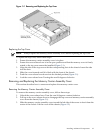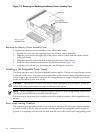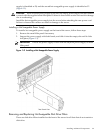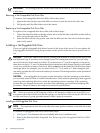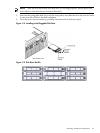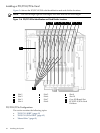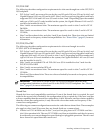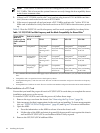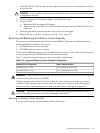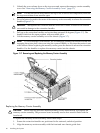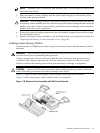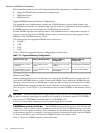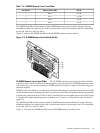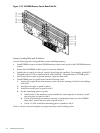
PCI/PCI-X IOBP
The following describes configuration requirements for slots one through ten on the PCI/PCI-X
I/O backplane:
• PCI-X slots 1 and 2 are reserved for use by the core I/O cards SAS core I/O card in slot 1 and
Gigabit Ethernet LAN core I/O card in slot 2. Slots 1 and 2 are not hot-pluggable. Install only
supported PCI-X SAS and LAN core I/O cards in slots 1 and 2.Depending upon the number
and type of SAS core I/O cards installed on the system, the Gigabit Ethernet LAN core I/O
card may be installed in slot 10.
• Slots 3 and 4 are nonshared slots. The maximum speed for cards in slots 3 and 4 is PCI-X
266 MHz.
• Slots 5 and 6 are nonshared slots. The maximum speed for cards in slots 5 and 6 is PCI-X
133 MHz,
• Slots 7 and 8 are shared slots, and slots, 9 and 10 are shared slots. These four slots are limited
by bus mode or frequency-related incompatibilities. See “Shared Slots” (page 63) for more
information.
PCI/PCI-X/PCIe IOBP
The following describes configuration requirements for slots one through ten on the
PCI/PCI-X/PCIe I/O backplane:
• PCI-X slots 1 and 2 are reserved for use by the core I/O cards SAS core I/O card in slot 1 and
Gigabit Ethernet LAN core I/O card in slot 2. Slots 1 and 2 are not hot-pluggable. Install only
supported SAS and LAN core I/O cards in slots 1 and 2. Depending upon the number and
type of SAS core I/O cards installed on the system, the Gigabit Ethernet LAN core I/O card
may be installed in slot 10.
• Slots 3 and 4 are swtiched PCIe x8. PCIe SAS core I/O is installed in slots 3 and 4 on the
PCI/PCI-X/PCIe IOBP.
• Slots 5 and 6 are nonswitched PCIe x8.
• Slots 7 and 8 are nonshared slots. The maximum speed for cards in slots 7 and 8 is PCI-X
133 MHz.
• Slots 9 and 10 are shared slots. These two slots are limited by bus mode or frequency-related
incompatibilities.
IMPORTANT: Slots 9 and 10 on the PCI/PCI-X/PCIe I/O backplane have the same
configuration limitations as slots 9 and 10 on the PCI/PCI-X/ I/O backplane. See “Shared
Slots” (page 63) for more information.
Shared Slots
Shared slots have card compatibility restrictions. If one of the shared slots is occupied, the card
added to the second slot is limited by the configuration of the occupied slot. If the new card has
a slower capability than the current bus configuration, it fails. If the new card has a faster capability
than the current bus configuration, it only runs at the slower bus mode and frequency of the
current bus configuration.
The following are common configuration scenarios for cards that use shared slots. These examples
also apply to slots 9 and 10 because they are shared (both use a common bus).
1. If there is a PCI-X 66 MHz card in slot 7, and you hot-plug insert a PCI 33 MHz card into
slot 8, the operation fails. The new PCI 33 MHz card does not initialize and the slot powers
down because you cannot change bus speed during hot-pluggable operations. The new card
has a slower bus speed than the current card.
Installing Additional Components 63





